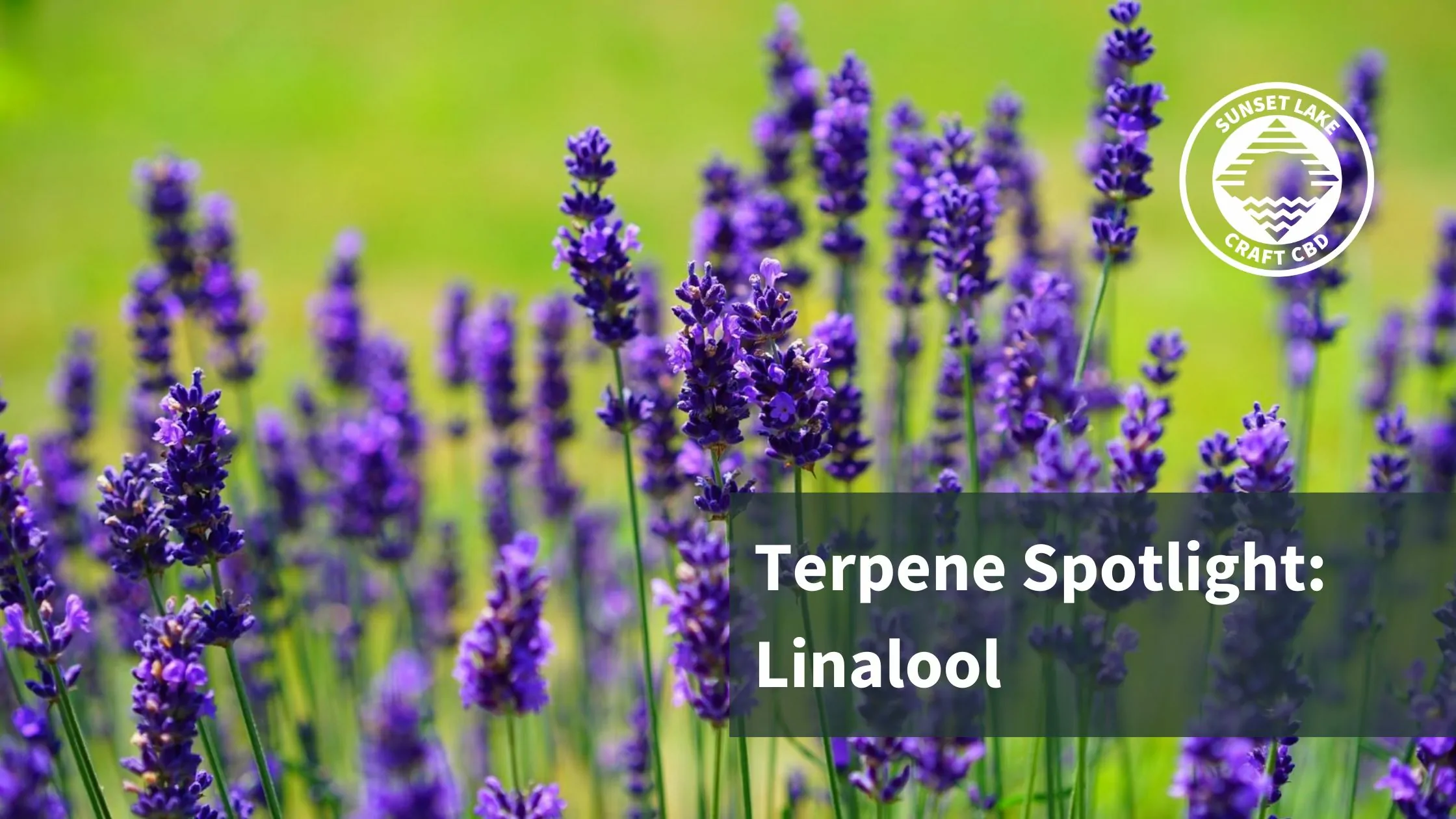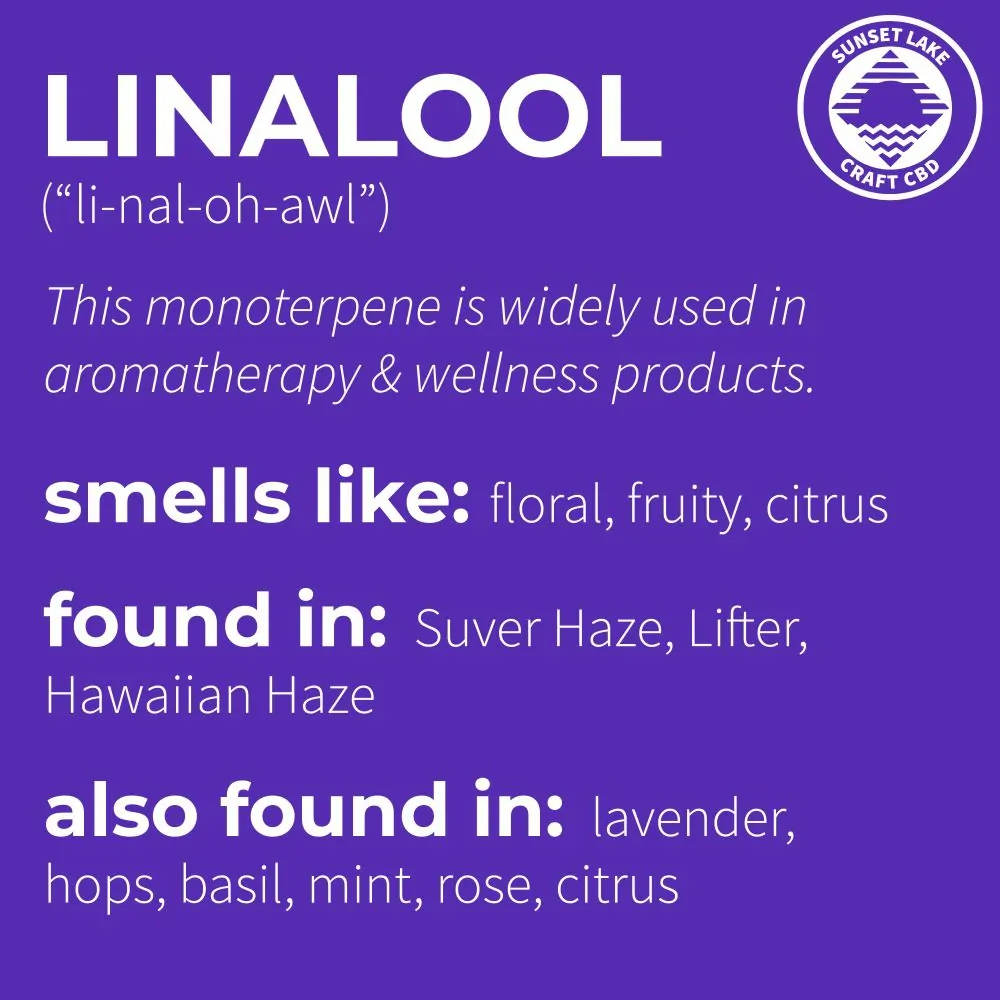No products in the cart.
Terpene Spotlight: Linalool

Hemp is a majestic plant rich in active compounds like cannabinoids—CBD, THC, and CBN—flavonoids, and molecules called terpenes. Terpenes have been thrust into the spotlight thanks to some new promising findings. But as it turns out, humans have used some terpenes for centuries in folk medicine practices. One such terpene is linalool, a primary component of lavender that has been used for healing the body and mind.
What is Linalool?
Linalool (“li-nal-oh-awl”) is rarely the dominant terpene in hemp, but it still plays a significant role in hemp’s aromatic profile. In addition to hemp and lavender, linalool can be found in many fruits and spices, including some varieties of citrus, mint, and hops.
Pronunciation Note:
Linalool looks like it should be pronounced “lin-ah-lewel,” but the correct pronunciation is “li-nal-oh-awl.” This odd pronunciation is due to the fact that the word is a combination of lináloe, a family of trees found in Mexico, and the suffix -ol, indicating that it is an alcohol molecule.

Overview of Terpenes
Terpenes are a class of volatile aromatic hydrocarbons made of isoprene units. The number of isoprene units determines the class of terpene: monoterpenes have two isoprenes, sesquiterpenes have three, and diterpenes have four isoprenes. There are other classes of terpenes, but these will suffice for our purposes here. Terpenes typically comprise about 1-2% of the weight of a hemp flower.
Terpenes are produced by many plants and even some animals. It is believed that plants produce terpenes as a way of repelling pests and attracting beneficial insects. The aroma of many plants is dictated, at least partially, by terpenes.
Common Terpenes:
- Black pepper and cinnamon get some of their kick from beta-caryophyllene.
- Chamomile gets its sweet floral scent from bisabolol.
- Apples and cumin contain terpinolene.
- Mangoes and cannabis contain high concentrations of myrcene.
Sources of Linalool
Linalool is a liquid at room temperature and is classified as a monoterpene alcohol. It was first isolated in 1875 from Cayenne Bois de Rose (rosewood) oil. Linalool is found in nature in a variety of sources, including many varieties of trees, roses, mint, basil, some citrus, hops, lavender, and hemp.
Botanists are still trying to sort out exactly why plants, including hemp, produce terpenes. So far, signs seem to point to terpenes as a defense mechanism against predators who might chomp on the flowers.
Interesting Fact:
Linalool is present in hops and can contribute significantly to the aroma of some craft beers, particularly dry-hopped lagers!
Linalool is not likely to be the dominant terpene in any given hemp cultivar, but there are some cultivars that contain significant quantities. Later in this post, we’ll share a list of the cultivars grown by Sunset Lake CBD and their linalool content.
Uses of Linalool
As an isolated chemical, linalool is mostly discussed in the production of vitamins, both as an intermediary and a byproduct. But as a constituent of many plant essential oils, linalool has been used by humans for centuries. For example, lavender flowers contain a significant amount of linalool and were widely used in ancient times by various groups around the Mediterranean, including the Greeks, Romans, and Persians. Knowledge of lavender’s healing power spread east, finding its way into Indian and Tibetan pharmacopeias. It was used for a wide variety of ailments including sleeplessness, pain, and topical healing.
Many products marketed as calming and relaxing are lavender-scented. Candles, incense, and some neck pillows are often treated with lavender essential oil to promote relaxation.
Potential Benefits of Linalool
With public interest in terpenes on the rise, scientific research into compounds like linalool is accelerating.
Potential Benefits:
- Anti-anxiety
- Sedative
- Local anesthetic
- Analgesic
- Anti-convulsant
- Burn treatment
- Anti-depressant
- Anti-parasite
Research is still ongoing, and we must be patient before jumping to conclusions about what linalool can and cannot do.
Sunset Lake CBD Cultivars Featuring Linalool
We grow our hemp under the sun at our farm in the Champlain Islands of Vermont with a particular focus on encouraging terpene production. We work with third-party certified testing laboratories to understand the terpene content from each harvest.
2022 Cultivars and Their Linalool Content:
- Suver Haze – 0.06%
- Lifter – 0.06%
- Hawaiian Haze – 0.03%
- Cherry Abacus – 0.02%
- Sour Lifter – 0.02%
- Candy Kush – 0.02%
- Super Sour Space Candy – 0.02%
Additional Insights on Linalool and Its Competitors
Comparison with Other Terpenes
While linalool is known for its calming and relaxing properties, other terpenes have unique benefits and characteristics. For instance, myrcene, found in mangoes and cannabis, is known for its sedative effects, making it popular for evening use. Beta-caryophyllene, present in black pepper and cinnamon, has been studied for its anti-inflammatory and pain-relief properties, offering potential therapeutic benefits for chronic pain conditions.
Terpenes like limonene, found in citrus fruits, are known for their uplifting and mood-enhancing effects. Limonene is often used in aromatherapy to reduce stress and anxiety, similar to linalool but with a more invigorating aroma. By understanding the diverse effects of different terpenes, consumers can make more informed choices about the hemp products they use, tailoring their selection to their specific needs and preferences.
Linalool in the Broader Market
Linalool is not just confined to hemp and lavender; it plays a significant role in the broader market of aromatherapy and essential oils. Products containing linalool are often marketed for their ability to reduce stress and promote relaxation. The essential oil industry has seen a surge in popularity, with consumers seeking natural remedies for common ailments. Linalool’s presence in essential oils like lavender oil makes it a staple in many households for promoting sleep and easing anxiety.
In comparison to synthetic compounds, linalool offers a natural alternative with a long history of use in traditional medicine. This trend towards natural products has driven demand for linalool-rich items, from candles and diffusers to skincare and wellness products. Understanding the market trends and consumer preferences can help companies like Sunset Lake CBD position their products more effectively.
Scientific Research and Future Potential
The scientific community continues to explore the potential benefits of linalool. Recent studies have focused on its neuroprotective properties, suggesting that linalool may have a role in protecting against neurodegenerative diseases like Alzheimer’s and Parkinson’s. These findings open up new possibilities for linalool in the pharmaceutical industry, where it could be developed into treatments for a variety of neurological conditions.
Moreover, linalool’s anti-inflammatory and analgesic properties are of great interest for developing new pain relief medications. As research progresses, we may see linalool being incorporated into mainstream medical treatments, further validating its therapeutic potential.
Consumer Education and Awareness
Educating consumers about the benefits and uses of linalool is crucial for increasing its adoption. Many people are unaware of the diverse applications and potential health benefits of this terpene. By providing clear and accessible information, companies can empower consumers to make informed choices. This education can be facilitated through blog posts, informational videos, and product labels that highlight the presence and benefits of linalool.
Consumers are increasingly looking for transparency and authenticity in the products they purchase. Highlighting the natural origins and traditional uses of linalool can resonate with this audience, fostering trust and loyalty. By positioning linalool as a key ingredient in their products, companies can tap into the growing market for natural wellness solutions.
Conclusion
Linalool is a fascinating terpene with a rich history and a promising future. Its calming and therapeutic properties make it a valuable component in both traditional and modern applications. As scientific research continues to uncover new benefits, and consumer awareness grows, linalool is poised to become a staple in the wellness industry. For more information visit our website.
FAQs
- What is linalool?
- It is a monoterpene alcohol found in various plants, including hemp and lavender, known for its aromatic properties and potential therapeutic benefits.
- Where can linalool be found naturally?
- It is found in many plants such as lavender, citrus fruits, mint, hops, basil, and some varieties of trees and roses.
- What are the potential benefits of linalool?
- Potential benefits include anti-anxiety, sedative, local anesthetic, analgesic, anti-convulsant, burn treatment, anti-depressant, and anti-parasite properties.
- Why does hemp produce linalool?
- It is believed that hemp produces linalool and other terpenes as a defense mechanism against pests and to attract beneficial insects.
- How is linalool used in everyday products?
- Linalool is used in products like lavender-scented candles, incense, neck pillows, and essential oils to promote relaxation and calmness.
